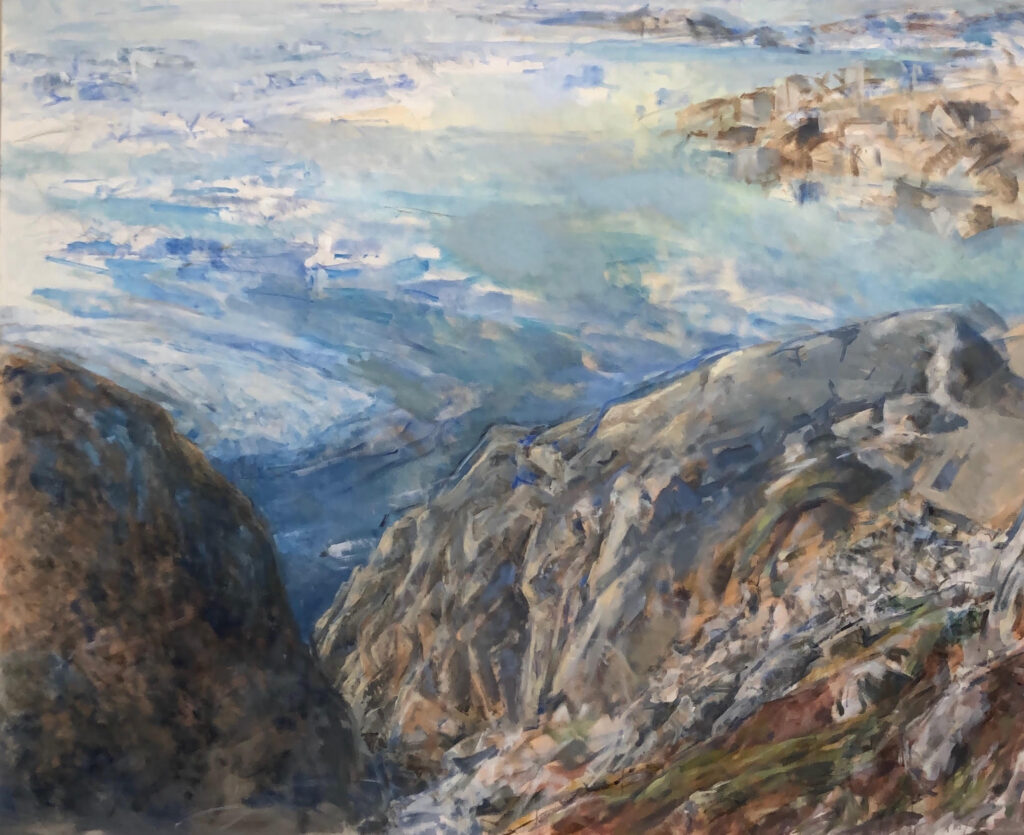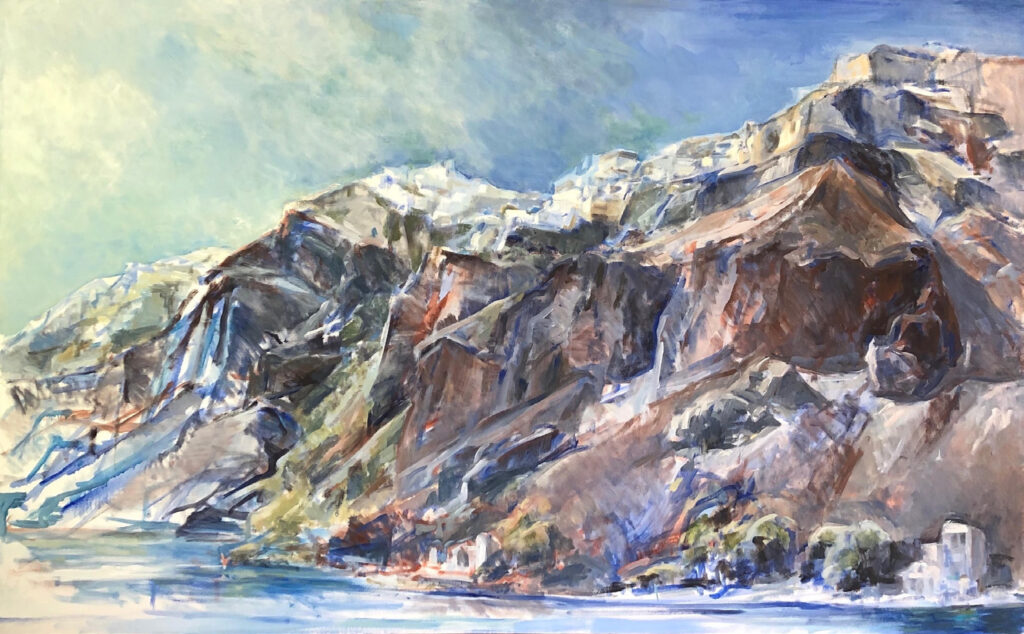Marcia Clark has traveled the earth from chilled north to warm Aegean, studying our fragile planet, interpreting icy and arid geographies in both plein air and studio. The results are oils laid down on assorted grounds. Her latest foray, “From the Aegean to the Arctic: Recent Paintings,” were shown at Blue Mountain Gallery, Chelsea, New York arises from her journeys to contrasting climes. Some are glacial and others warmly sea-kissed, where topographies, though disparate, share affinities in renderings of sweeping panoramas with paint forcefully layered and controlled with chromatic selections

Clark’s depictions of an Alaskan glacier, her light drenched interpretations of Mediterranean Crete, Siena and Santorini share similarities, faceting subjects into mesmerizing geometrics, almost toppling on each other as semi-abstracts. In the paintings of Ammoudi, Greece, the artist skillfully melds the nestled buildings amid the craggy rock cliffs, covered in sunshine by merging the town’s sepia tones with its surroundings as the work grows from short-stroked oil dilutions into sweeping terrains. Layering washes, the technique used principally in “Arriving at Oia,” builds quick cool gestures into huge crescendos of powerful chromatic symphony with overwhelming rocks thrusting up from a tranquil blue harbor. The artist intimates a white-washed small village at the very top of the rocks, balancing at its location for centuries, above the towering crags and watching over the azure waters below.
The painter’s compositions are understated where she concentrates on the essence of subjects. This can be seen in the dramatic depiction of hikers straining to climb rocks in the painting, “Balos,” a gestural tour-de-force. The people struggle up the painting’s diagonal, their bodies almost overwhelmed by the harsh rock faces as they are swallowed up by an unforgiving landscape.
Clark transcends the physical landscape in her mystical panoramic views and like Thomas Cole, her luminous works are infused with metaphorical meanings. Thomas Cole painted the optimistic expansiveness of the new American vision. Clark paints nature’s expansiveness but now tainted by a warning about the possible destruction of our modern world, The pristine depictions of a Hudson River painter are now sullied by our callous lack of environmental stewardship.
The artist’s portrayals of glacial ice provide cool contrasts to the warm Mediterranean pieces, their creation bearing witness to our planet’s perilously changing climate. In addition to her consummate artistic talents, Clark is also a teacher and serious naturalist, informed by the work of John Muir, Alan Gussow and numerous meteorological scientists of the past, as she pursued residencies supporting her natural world travels. Her quest for painting the natural world imbued with emotional resonance while showing the current state of dangerous flux, brings forth profundity through the brushwork and understated color manipulations.
Clark has endured physical hardships during her treks to capture nature’s vast expanses, even experiencing perilously numbing ice and snow on her journeys. Her courage to work in harsh environments has contributed to her use of novel materials, such as gessoed aluminum or Mylar helping to convey glistening luminosity. Varied media support her simplifications of the mammoth frozen water and from her handling of the paint, the congealment is almost palpable. As abstractions Clark’s paintings remind me compositionally of painter, Louisa Louisa Matthíasdóttir, but unlike this Scandinavian artist, she eschews bright colors bringing a sense of isolation to the pieces, contributing to their psychic depth.

Clark has long used map transfers to identify specific locations, however in recent works, the map transfers have been used abstractly, peeking through the canvas surfaces adding their own sense of texture to the topological depictions. Underscoring Clark’s sober respect for time’s passage, she inventively expresses our planet’s rock-laden immutability. Her oil on canvas with map transfer depiction of Muldrow Glacier captures profoundly the effects of global warming on the ice, the deglaciation process becoming real to us as the crashing ice forms rendered over the map pieces plead for us to work for climate change mitigation in all that we do.
Marcia Clark has had a wide range of artistic experiences throughout her long, impressive career. She has met and learned from people who broadened her appreciation of the significance of life on our planet. In her paintings she has sought to communicate our home’s fragile uniqueness. Her works are stories of where the paintings come from, and her heart is a beacon of human light to guide our survival as we attempt solutions to our daunting environmental dilemmas. All of us owe this artist a great debt for her efforts to inform and move us to action. G&S





Leave a Comment